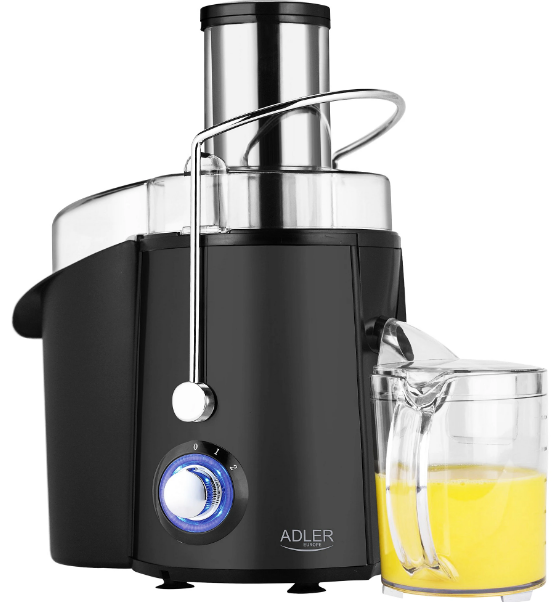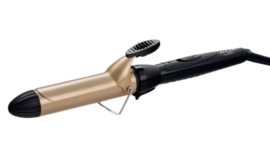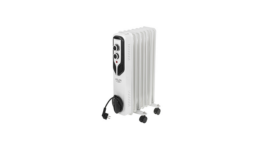ADLER AD 4127 Juicer Makers

SAFETY INSTRUCTION
GENERAL SAFETY CONDITIONS IMPORTANT INSTRUCTIONS ON SAFETY OF USE PLEASE READ CAREFULLY AND KEEP FOR FUTURE REFERENCE
The warranty conditions are different if the device is used for commercial purposes.
- Before using the product please read carefully and always comply with the following instructions. The manufacturer is not responsible for any damages due to any misuse.
- The product is only for home use. Do not use the product for any purpose that is not compatible with its application.
- The applicable voltage is 220-240V ~ 50/60Hz. For safety reasons, it is not appropriate to connect multiple devices to one power outlet.
- Please be cautious when using around children. Do not let the children play with the product. Do not let children or people who do not know the device use it without supervision.
- WARNING: This device may be used by children over 8 years of age and persons with reduced physical, sensory, or mental capabilities, or persons without experience or knowledge of the device, only under the supervision of a person responsible for their safety, or if they were instructed on the safe use of the device and are aware of the dangers associated with its operation. Children should not play with the device. Cleaning and maintenance of the device should not be carried out by children unless they are over 8 years of age and these activities are carried out under supervision.
- Never put the power cable, the plug, or the whole device into the water. Never expose the product to atmospheric conditions such as direct sunlight or rain, etc. Never use the product in humid conditions.
- Periodically check the power cable condition. If the power cable is damaged the product should be turned to a professional service location to be replaced to avoid hazardous situations.
- Never use the product with a damaged power cable if it was dropped or damaged in any other way or if it does not work properly.
- Do not try to repair the defective product yourself because it can lead to electric shock. Always turn the damaged device to a professional service location to repair it. All the repairs can be done only by authorized service professionals. The repair that was done incorrectly can cause hazardous situations for the user.
- Never put the product on or close to the hot or warm surfaces or the kitchen appliances like the electric oven or gas burner.
- Never use the product close to combustibles.
- Do not let the cord hang over the edge of the counter or touch hot surfaces.
- Before cleaning or after use, remove the plug from the socket by holding the socket with your hand. DO NOT pull the power cable.
- Never use this device close to water, e.g.: under the shower, in the bathtub, or above a sink filled with water.
- If using the device in the bathroom after use remove the power plug from the power socket, because water proximity presents a risk, even if the device is turned off.
- Do not allow the device or power adaptor to wet. If the device falls into water, immediately remove the power plug or power adaptor from the socket. If the device is powered, do not put your hands in the water. Have the device checked by a qualified electrician before using it again?
- Do not touch the device with wet hands.
- The device has to be turned off after every use.
- Never leave the product connected to the power source without supervision. Even when use is interrupted for a short time, turn it off from the network, and unplug the power.
- To provide additional protection, it is recommended to install a residue current device (RCD) in the power circuit, with a residual current rating of not more than 30 mA. Contact a professional electrician in this matter.
- Before you turn on your device, make sure that all parts are installed correctly. Plug it only with put on cover (8), well established security arm (11), properly installed feeder (2).
- Before each use, check out the juicer filter. If you see any cracks or damage, do not use the device.
- Use the device only when the safety lock is closed.
- Do not touch the blades of the small mesh filter and stainless steel grater (9).
- Use only accessories supplied by the manufacturer.
- Do not remove the container to a pulp during the operation.
- During operation, do not put your hands or any objects into the feeder (2). To push fruits, use only the pusher (1).
- Fruits should be put into the feeder during operation, you can not fill the feeder with fruit or vegetables at a standstill.
- Be careful not to overload the juicer, and do not use too much force to push products through the filling hole (2).
- Always unplug the appliance and disconnect the power cord from the unit when not in use, or want to start cleaning it.
- Do not disassemble the juicer if it is plugged into a power outlet.
- Open the safety lock after switching off the appliance and the filter stops.
- Do not immerse the motor part in water or any other liquid.
- The device can not work longer than 3 minutes without interruption. After three minutes, wait 20 minutes.
- During the extrusion of thick juice, juicers do not switch on for more than 1 minute.
DESCRIPTION OF DEVICE
- Pusher
- Feeder
- Pulp container
- Power cord
- 3-position switch
- Base with motor
- Spout
- Cover
- Grater and filter sieve
- Juice and pulp separating bowl
- Safety locking handle
- Safety switch
BEFORE FIRST USE
- Wash the parts of the unit, which will be in contact with food.
- Try to assemble and disassemble the unit a few times before starting work with the units.
ASSEMBLING THE DEVICE
- Place the juice and pulp separating bowl (10) on the base (6).
- Install the stainless steel grater and filter sieve (9) and then put the cover on (8).
- Be careful not to touch the sharp teeth on the bottom of the sieve.
- Make sure that the sieve sits properly on its base so that the gear on the bottom of the sieve bowl engages the gear in the base.
- Make sure that the grater and filter sieve are not too loose on the base and that they rotate evenly.
- Close the safety locking handle (11).
- Insert the large pulp container (3) correctly, and place the juice jug on the opposite side of the juicer. NOTE: Before turning the device on, make sure that all parts are properly installed.
USE
- Place the juicer on a smooth, flat, and stable surface.
- Wash the fruit or vegetables you want to use. In case they do not fit in the feeder (2), cut them into smaller pieces.
- Make sure the juicer is assembled correctly.
- Make sure that the stainless steel filter (9) has been thoroughly washed.
- Make sure the juice jug is placed under the spout (7).
- Put the plug into the power socket and turn on the device by setting the switch to the ‘1’ or ‘2’ position. Depending on the fruit or vegetables used, use the speed switch (5) to change the speed to low (switch in ‘1’ position) or high (switch in ‘2’ position).
- With the engine running, place the fruit (or vegetables) in the feeder (2). Use the pusher (1) to push them down. To get as much juice as possible, push the fruit slowly.
- Juice will start to drain into the jug and the pulp will start to collect in the container on the other side. To empty the pulp container (3), switch off the juicer. Do not empty the container when the device is running and be careful not to overfill it, as it may damage the device.
NOTE: The machine is fitted with a safety switch (12). It prevents the juicer from being started unintentionally.
DISASSEMBLY OF THE DEVICE
- Turn the 3-position switch (5) to the ‘O’ position. Unplug the power cord of the juicer from the power socket. Release the safety handle (11).
- Remove the cover (8).
- Remove the juice and pulp separating bowl (10), then pull the stainless steel grater and filter basket (9) upwards.
TECHNICAL DATA
- Voltage: 220-240V ~ 50/60Hz
- Nominal power: 1000W
- Maximum power: 2000W
- Maximum operation time: 3min – 20 minutes break
- Two speeds mode: Hi – switch in position ‘2’, Low – switch in position ‘1’.
CLEANING AND MAINTENANCE
- For easy cleaning – immediately after each use rinse removable parts under running water (to remove wet pulp). Allow parts to dry.
- After disassembling the unit all removable parts may be washed in hot soapy water.
- The cover (8) with the feeder (2), juice and pulp separating bowl (10), pulp container (3), and juice jar are dishwasher safe.
- Wipe the motor base (6) with a damp cloth.
- Do not soak the stainless steel grater and filter sieve (9) in bleach.
- Always treat the filter (9) with care as it can be easily damaged.
- Discoloration of the plastic may occur with strongly colored fruits and vegetables. To help prevent this, wash parts immediately after
use. - If discoloration does occur, the plastic parts can be soaked in 10% lemon juice and water or they can be cleaned with a non-abrasive
cleaner. To assist with cleaning soak the stainless steel grater and filter sieve (9) in hot soapy water for approximately 10 minutes
immediately after juicing is completed. If pulp is left to dry on the filter it may clog the fine pores of the filter mesh thereby lessening the effectiveness of the juicer.
NOTE: Never immerse the motor part in water or rinse under the tap. - Do not use abrasive pads or aggressive agents for cleaning.
Disposal
Please transfer cardboard packaging to waste paper. Pour the polyethylene bags (PE) into the plastic container Worn device should be returned to the appropriate point of storage because it is dangerous in the device ingredients may pose a threat to the environment. The electrical device should be handed over to limit its reuse and use. If in the device there are batteries you have to them and give them the point stored separately.
AFTER-SALE SERVICE NOTICE
If you want to buy spare parts or make any complaints, please get in touch with the seller who issued the receipt directly.
For More Manuals by ADLER, Visit LatestManuals
- ADLER AD 4070 Black Multi-Color User Manual
- ADLER AD1244 Electric Kettle User Manual
- Takeya Patented Deluxe Cold Brew Coffee Maker User Guide
- ADLER AD 7815 Oil Radiator User Manual
Faqs About ADLER AD 4127 Juicer Makers
What is important when buying a juicer?
Think about the color of your kitchen’s other appliances, the size, and shape of your juicer, and how much room you need around it for the collector bowls and the produce you’re juicing. You should also think about the area above your juicer where you’ll need to reach the hopper to feed
What is the purpose of a juicer machine?
Juicing is the technique of extracting juice from fruits, vegetables, herbs, and leafy greens using a device called a juicer, also called a juice extractor. It grinds, smashes, and/or presses the pulp to extract its juice.
What type of juicer is healthiest?
masticating juicer Therefore, if you want to start juicing to lead a better lifestyle, it’s imperative to know which juicer retains the most nutrients. The finest juicer for nutrients is said to be a masticating juicer.
What are juicers made of?
Most personal-use juicers employ metal discs or augers that are composed of both plastic and metal. Because of this, personal juicers are frequently less expensive. Since stainless steel is meant to withstand extensive use, commercial juicers frequently employ it.
What is the principle of a juicer?
The veggies you’ve pushed down the chute of a centrifugal juicer are ground into a pulp while it spins at a fast pace. The juice is subsequently forced away from the pulp by the spinning motion. After that, the juice flows into a bowl.
Which juicing method is best?
Juicing fruits, vegetables, and herbs is the main purpose of a juicer, a tiny kitchen gadget.
What does a juicer do in cooking?
Because masticating juicers generate a large amount of dry pulp, there is less dirty waste. Juicers that masticate and triturate are perfect for items like leafy greens. A centrifugal juicer can be the ideal choice for you if you intend to juice a lot of fruits and hard veggies.
Is the juicer healthy?
In brief. Slow juicers operate between 50 and 60 revolutions per minute. A fast juicer’s rotation speed is approximately 12,000 RPM. Slower cooking preserves nutrients better but requires more time.
Is a juicer fast or slow?
In brief. Slow juicers operate between 50 and 60 revolutions per minute. A fast juicer’s rotation speed is approximately 12,000 RPM. Slower cooking preserves nutrients better but requires more time.
How loud are juicers?
A dB louder, perhaps, but perhaps more akin to the hum of a microwave. I assume that’s why mine creaks a little bit—it was rebuilt. It also relies on the way sound moves through your house. This is my third attempt at a different name-brand juicer, and it is one of the best that I have used thus far.




